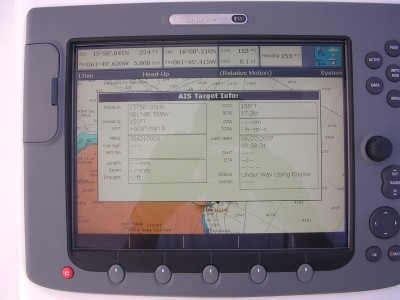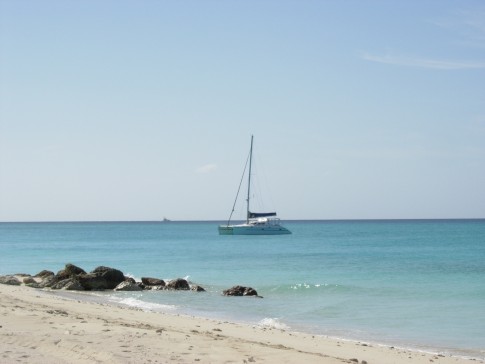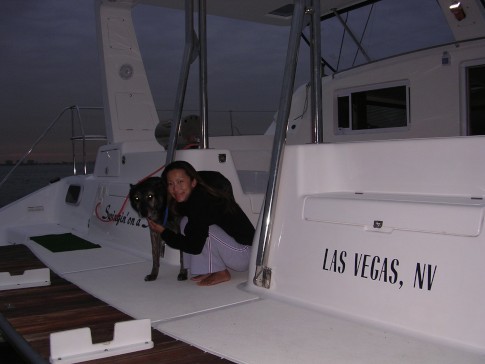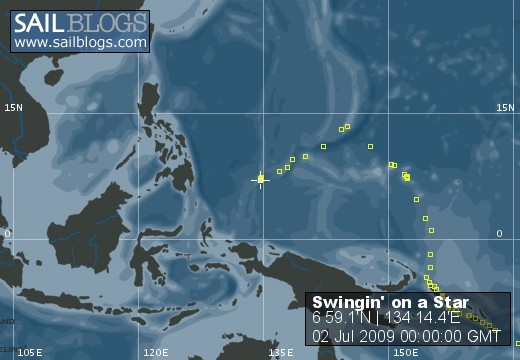
Swingin' on a Star
Ship's log for the circumnavigating Saint Francis 50 catamaran, "Swingin on a Star".
01 April 2010 | Palau
13 July 2009 | Palau
05 July 2009 | Yacht Harbor
03 July 2009 | Peleliu
02 July 2009 | Palau
01 July 2009 | Two Dog Beach
30 June 2009 | Mecharchar
29 June 2009 | Mecharchar
28 June 2009 | Ulong
27 June 2009 | Ngeruktabel
17 June 2009 | Ngeruktabel
16 June 2009 | Ngeruktabel
15 June 2009 | Ngeruktabel
14 June 2009 | Ngeruktabel
13 June 2009 | Ngerutable
25 May 2009 | Yacht Harbor
30 April 2009 | Malakal
29 April 2009 | Koror
28 April 2009 | Malakal
27 April 2009 | Malakal
AIS
08 June 2007 | FKG Dock
Randy

AIS rules. AIS is the Automated Information System required on most commercial vessels and large pleasure boats. Cruising boats can get a receiver and easily pick up this information for display or chart plotter integration.
An AIS transmitter broadcasts a vessel's name, position, heading, speed, destination, ETA, mode of propulsion, length, beam, draft, MMSI and more over VHF. A well placed antenna will pick up shipping traffic 15 to 20 miles off. Because the system provides location, course over ground and speed over ground you can very accurately predict a collision danger.
I wanted to install this in Fort Lauderdale but the unit I ordered (Sitex) didn't arrive in time. It has been in my project box for a while now. Our friends on Rosario have AIS running and I was so jealous when we discussed it with them in the Bahamas. David said that one of his favorite things about AIS was that he could hail the other vessel by name. Getting on 16 and hailing "shipping traffic at lat/long" is likely to turn up dead air. Hailing "Andrea Star", gets their attention (perhaps wondering who is close enough to read the name on the bow).
I order the Sitex unit because that was what Raymarine used in their demo booth at the '06 Miami boat show (they now have their own unit). You can do a quick and dirty install but if you go by the book it is a fair amount of work. The AIS receiver needs its own antenna. If you hook it up to your VHF every time you transmit you blast the AIS, possibly loosing data, possibly damaging the AIS box. I decided to put the antenna on the port side of the traveler arch rather than opening the can of worms that installing it at the top of the mast (the optimal place) would have been.
I had my SSB and VHF hooked up to the E120 chart plotter NEMA port for position data and DSC info. They run at 19,200 though and the AIS can output a lot of data in a busy port and prefers 384,000. This means you need to get a NEMA to SeaTalk bridge to support the radios so that you can crank up the port speed on the NEMA to 384,000. Check. Once everything is installed you need to make sure that you have a newish version of the E120 software running.
Our setup is running and it is fantastic. I wish we had it crossing the Gulf Stream and the windward passage. The E120 has a bug causing it to alarm every time you get into a situation where there are no targets. This is annoying but hopefully a fix is on the way.
An AIS transmitter broadcasts a vessel's name, position, heading, speed, destination, ETA, mode of propulsion, length, beam, draft, MMSI and more over VHF. A well placed antenna will pick up shipping traffic 15 to 20 miles off. Because the system provides location, course over ground and speed over ground you can very accurately predict a collision danger.
I wanted to install this in Fort Lauderdale but the unit I ordered (Sitex) didn't arrive in time. It has been in my project box for a while now. Our friends on Rosario have AIS running and I was so jealous when we discussed it with them in the Bahamas. David said that one of his favorite things about AIS was that he could hail the other vessel by name. Getting on 16 and hailing "shipping traffic at lat/long" is likely to turn up dead air. Hailing "Andrea Star", gets their attention (perhaps wondering who is close enough to read the name on the bow).
I order the Sitex unit because that was what Raymarine used in their demo booth at the '06 Miami boat show (they now have their own unit). You can do a quick and dirty install but if you go by the book it is a fair amount of work. The AIS receiver needs its own antenna. If you hook it up to your VHF every time you transmit you blast the AIS, possibly loosing data, possibly damaging the AIS box. I decided to put the antenna on the port side of the traveler arch rather than opening the can of worms that installing it at the top of the mast (the optimal place) would have been.
I had my SSB and VHF hooked up to the E120 chart plotter NEMA port for position data and DSC info. They run at 19,200 though and the AIS can output a lot of data in a busy port and prefers 384,000. This means you need to get a NEMA to SeaTalk bridge to support the radios so that you can crank up the port speed on the NEMA to 384,000. Check. Once everything is installed you need to make sure that you have a newish version of the E120 software running.
Our setup is running and it is fantastic. I wish we had it crossing the Gulf Stream and the windward passage. The E120 has a bug causing it to alarm every time you get into a situation where there are no targets. This is annoying but hopefully a fix is on the way.
Comments
| Vessel Name: | Swingin' on a Star |
| Vessel Make/Model: | Saint Francis 50 |
| Hailing Port: | Las Vegas, NV |
| Crew: | Randy Abernethy |
| Home Page: | http://swinginonastar.com |
Swingin on a Star

Who: Randy Abernethy
Port: Las Vegas, NV






